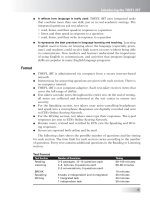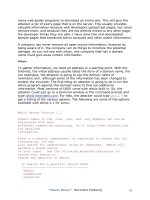Lecture Security + Guide to Network Security Fundamentals (2th edition) - Chapter 3: Security basics
Bạn đang xem bản rút gọn của tài liệu. Xem và tải ngay bản đầy đủ của tài liệu tại đây (767.47 KB, 38 trang )
Chapter 3: Security Basics
Security+ Guide to Network Security
Fundamentals
Second Edition
Objectives
• Identify who is responsible for information security
• Describe security principles
• Use effective authentication methods
• Control access to computer systems
• Audit information security schemes
Identifying Who Is Responsible for
Information Security
• When an organization secures its information, it
completes a few basic tasks:
– It must analyze its assets and the threats these assets
face from threat agents
– It identifies its vulnerabilities and how they might be
exploited
– It regularly assesses and reviews the security policy to
ensure it is adequately protecting its information
Identifying Who Is Responsible for
Information Security (continued)
• Bottom-up approach: major tasks of securing
information are accomplished from the lower levels of
the organization upwards
• This approach has one key advantage: the bottomlevel employees have the technical expertise to
understand how to secure information
Identifying Who Is Responsible for
Information Security (continued)
Identifying Who Is Responsible for
Information Security (continued)
• Top-down approach starts at the highest levels of the
organization and works its way down
• A security plan initiated by top-level managers has
the backing to make the plan work
Identifying Who Is Responsible for
Information Security (continued)
• Chief information security officer (CISO): helps
develop the security plan and ensures it is carried out
• Human firewall: describes the security-enforcing role
of each employee
Understanding Security Principles
• Ways information can be attacked:
– Crackers can launch distributed denial-of-service
(DDoS) attacks through the Internet
– Spies can use social engineering
– Employees can guess other user’s passwords
– Hackers can create back doors
• Protecting against the wide range of attacks calls for
a wide range of defense mechanisms
Layering
• Layered security approach has the advantage of
creating a barrier of multiple defenses that can be
coordinated to thwart a variety of attacks
• Information security likewise must be created in
layers
• All the security layers must be properly coordinated
to be effective
Layering (continued)
Limiting
• Limiting access to information reduces the threat
against it
• Only those who must use data should have access
to it
• Access must be limited for a subject (a person or a
computer program running on a system) to interact
with an object (a computer or a database stored on a
server)
• The amount of access granted to someone should be
limited to what that person needs to know or do
Limiting (continued)
Diversity
• Diversity is closely related to layering
• You should protect data with diverse layers of
security, so if attackers penetrate one layer, they
cannot use the same techniques to break through all
other layers
• Using diverse layers of defense means that
breaching one security layer does not compromise
the whole system
Diversity (continued)
• You can set a firewall to filter a specific type of traffic,
such as all inbound traffic, and a second firewall on
the same system to filter another traffic type, such as
outbound traffic
• Using firewalls produced by different vendors creates
even greater diversity
Obscurity
• Obscuring what goes on inside a system or
organization and avoiding clear patterns of behavior
make attacks from the outside difficult
Simplicity
• Complex security systems can be difficult to
understand, troubleshoot, and feel secure about
• The challenge is to make the system simple from the
inside but complex from the outside
Using Effective
Authentication Methods
• Information security rests on three key pillars:
– Authentication
– Access control
– Auditing
Using Effective Authentication
Methods (continued)
• Authentication:
– Process of providing identity
– Can be classified into three main categories: what you
know, what you have, what you are
– Most common method: providing a user with a unique
username and a secret password
Username and Password (continued)
• ID management:
– User’s single authenticated ID is shared across
multiple networks or online businesses
– Attempts to address the problem of users having
individual usernames and passwords for each account
(thus, resorting to simple passwords that are easy to
remember)
– Can be for users and for computers that share data
Tokens
• Token: security device that authenticates the user by
having the appropriate permission embedded into the
token itself
• Passwords are based on what you know, tokens are
based on what you have
• Proximity card: plastic card with an embedded, thin
metal strip that emits a low-frequency, short-wave
radio signal
Biometrics
• Uses a person’s unique characteristics to
authenticate them
• Is an example of authentication based on what
you are
• Human characteristics that can be used for
identification include:
– Fingerprint
– Face
– Hand
– Iris
– Retina
– Voice
Biometrics (continued)
Certificates
• The key system does not prove that the senders are
actually who they claim to be
• Certificates let the receiver verify who sent the
message
• Certificates link or bind a specific person to a key
• Digital certificates are issued by a certification
authority (CA), an independent third-party
organization
Kerberos
• Authentication system developed by the
Massachusetts Institute of Technology (MIT)
• Used to verify the identity of networked users, like
using a driver’s license to cash a check
• Typically used when someone on a network attempts
to use a network service and the service wants
assurance that the user is who he says he is
Kerberos (continued)
• A state agency, such as the DMV, issues a driver’s
license that has these characteristics:
– It is difficult to copy
– It contains specific information (name, address, height,
etc.)
– It lists restrictions (must wear corrective lenses, etc.)
– It expires on a specified date
• The user is provided a ticket that is issued by the
Kerberos authentication server (AS), much as a
driver’s license is issued by the DMV









